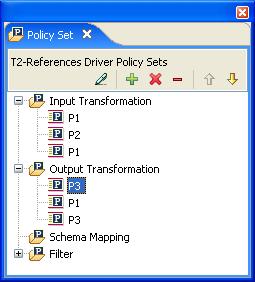7. Policy & Simulation: What's New
(Home) Previous
Next
1. Support for Simulating Policy References
This version of Designer has enhancements to the Simulator, which allows users
to simulate DirXML Script "include" statements, XSLT variable assignments, and
references in DirXML Script to the new ECMAScript and Mapping Table
objects introduced in version 3.5 of Identity Manager.
Include Statements
The include statement causes the rules from the referenced policy to be included
at runtime into the including policy. The following link to bugzilla includes an
attached driver configuration file that contains an example DirXML Script policy with an
include statement.
Click here for an "include" example.
ECMAScript
ECMAScript objects are resource objects that store ECMAScripts. The ECMAScript is used by policies
and style sheets. The following link to bugzilla includes an attached driver configuration file that
contains an example DirXML Script policy and ECMAScript object.
Click here for an "ECMAScript" example.
Mapping Tables
Mapping tables were introduced in Identity Manager 3.5. A Mapping Table object is used by a policy to map a set
of values to another set of corresponding values. The Mapping Table object is referenced within DirXML Script
by the token-map verb. The following link to bugzilla includes an attached driver configuration file that
contains an example DirXML Script policy and Mapping Table object.
Click here for a "Mapping Table" example.
For complete documentation on the ECMAScript and Mapping Table Identity Manager features, refer
to the chapter entitled "Resource Objects" in the
Identity Manager 3.5 documentation.
2. Added Support for Identity Manager 3.5 Policy Linkage
The previous versions of Identity Manager used a policy linkage
architecture that made it difficult to include a policy in multiple
policy sets. The link was maintained by the eDirectory policy object
and could contain only a single value. This meant that a policy
could not point to two different policies. The following image
shows an example where P1 had a link to P2. Therefore,
both the Input and Output Transformation policy sets had to contain
P1 and P2.

The new policy linkage architecture maintains the linkage on the
Driver object instead of on the policy. This allows the policies to
be reused more easily. The following figure illustrates the
new policy linkage, where P1 is linked to P2 in the
Input Transformation but is linked to P3 in the Output Transformation.

This new policy linkage also allows a policy to be used in a policy set
multiple times, as shown in the following example.

For complete documentation on the new policy linkage, refer to the
"Upgrading Identity Manager Policies" chapter in the
Identity Manager 3.5 documentation.
(Home) Previous
Next